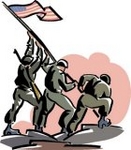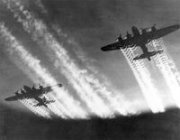
Worksheets and No Prep Teaching Resources
Reading Comprehension Worksheets
World War II

World War II
 Worksheets and No Prep Teaching Resources Reading Comprehension Worksheets World War II |
 World War II |
| edHelper's suggested reading level: | grades 6 to 8 | |
| Flesch-Kincaid grade level: | 4.54 |
|
Hazardous Duty - Bombers of WWII and their Crews
By Toni Lee Robinson |

|
 1 Fighter planes were lean and agile, built for the tense ballet of aerial combat. Bombers, in contrast, were the brawny, "blue-collar" part of the air war. Their job was clear-cut and basic, but far from easy. The bomber had to have muscle. Besides its heavy load, it also had to bring along enough fuel to get into enemy airspace and back home again.
1 Fighter planes were lean and agile, built for the tense ballet of aerial combat. Bombers, in contrast, were the brawny, "blue-collar" part of the air war. Their job was clear-cut and basic, but far from easy. The bomber had to have muscle. Besides its heavy load, it also had to bring along enough fuel to get into enemy airspace and back home again. |
Create Weekly Reading Books
Prepare for an entire week at once! |
| Leave your feedback on Hazardous Duty - Bombers of WWII and their Crews (use this link if you found an error in the story) |
 |
World War II
|
 |
Social Studies
|
 |
United States
|
|
|
|
|
 | Fifty States Theme Unit |
 |
Document Based Activities |